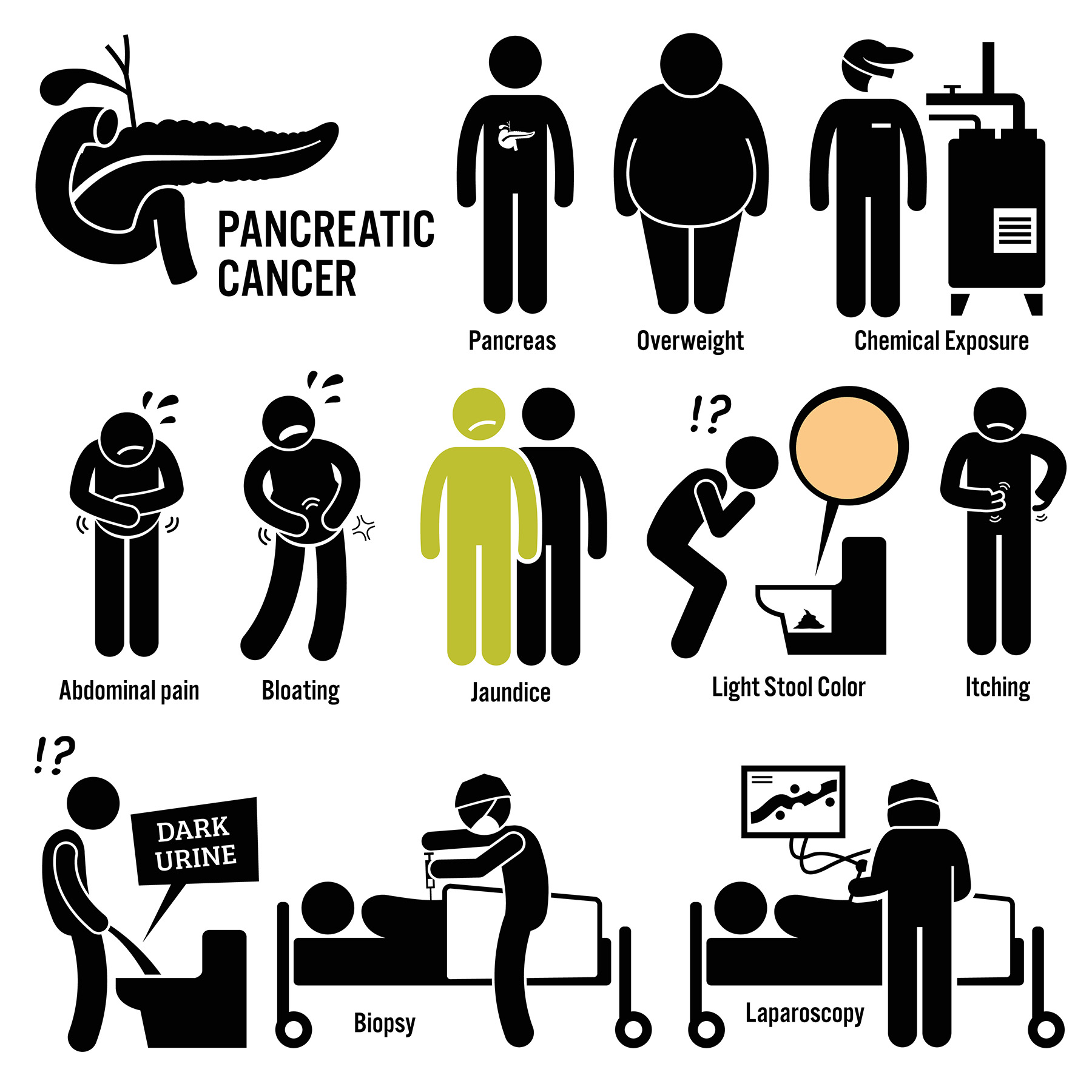The diagnosis is devastating. As the third-leading cause of cancer deaths in America and with just a 9 percent survival rate, pancreatic cancer is one of the deadliest forms of cancer. There are no known causes of pancreatic cancer, and while there are some risk factors, such as family history, diabetes and obesity, many people who are diagnosed with pancreatic cancer have none of these. Plus, there are no early detection tests. Too often, by the time someone is diagnosed with pancreatic cancer, the cancer is already at an advanced stage.
One way to be prepared for a diagnosis of pancreatic cancer is to keep keenly aware of symptoms and treatment options, which include:
Signs & Symptoms of Pancreatic Cancer
Some cancers are unmistakable when they appear – for example, with the presence of tumors or moles, or may be detected through blood tests.
The signs and symptoms of pancreatic cancer, however, are deceptively vague and too often are disregarded as a normal part of aging or other health conditions.
Signs and symptoms you should look for include:
- Mid- to upper-back pain. Back pain is something too many of us suffer from. But if the pain is chronic and the usual treatments such as anti-inflammatories or chiropractic care don’t provide relief, consider getting checked out right away.
- Weight loss/loss of appetite. If you are on a hardcore regimen to lose weight, then you will experience success. However, unintended weight loss should be a cause for concern. If you are eating but still losing weight, or if you have lost your appetite, this could be a sign of pancreatic cancer.
- Pain in the abdominal area and/or nausea; changes in stool. Abdominal pain or changes in bowel consistency can be the result of many things, including Crohn’s disease, diverticulitis, or irritable bowel syndrome. Stress and anxiety can also cause pain in the abdominal area, nausea, and changes in your stool. If you haven’t been diagnosed with any gastrointestinal diseases and remedies such as changes in your diet or medications such as antacids (for stomachache) or anxiety medications (for stress) aren’t working, this could be a sign of pancreatic cancer. With regard to stool changes, keep an eye out for oily or watery stools, which could be indicative of the disease, especially if it occurs in conjunction with other symptoms.
- Jaundice. If you are noticing a yellowing of your skin or eyes, you may have jaundice, which is caused by an excess of the pigment bilirubin. Jaundice results from liver disease, obstruction of the bile duct, or an excessive breakdown of red blood cells. Jaundice is also a sign of pancreatic cancer and anyone with jaundice should receive medical care.
- New onset of diabetes. While long-standing diabetes (someone who has had diabetes for five years or more) is a known risk factor for pancreatic cancer, new onset of diabetes should be cause for concern, especially if you aren’t pregnant, your eating or lifestyle habits have not changed, and you have no family history of diabetes.
Treatment Options for Pancreatic Cancer
If you are experiencing one or more of the above symptoms and there is no other known cause, see your doctor for an evaluation. If you are diagnosed with pancreatic cancer, your treatment options include:
- Surgery. Surgical treatment of pancreatic cancer is less common than you might think. For patients diagnosed with adenocarcinoma, the most common type of pancreatic cancer, surgery is indicated only 20 percent of the time.
- Chemotherapy. This is often performed when the cancer cannot be removed by surgery – or in conjunction with surgery when it can.
- Radiation. Radiation therapy is often effective, especially when combined with chemotherapy.
- Clinical trials. Your doctor may also recommend you undergo a clinical trial if there are new or experimental treatments being investigated and nothing else has worked.
- CyberKnife. This state-of-the-art, advanced radiosurgery technique works by delivering high dosages of radiation to specific parts of the body to destroy tumors. CyberKnife therapy has provided a ray of hope to pancreatic cancer patients who are considered poor candidates for surgery, or for whom other treatments have failed. The procedure is noninvasive and uses a device with a robotic arm to deliver high dose beams of radiation to the precise area where the tumor is located without harming any surrounding healthy tissue.
CyberKnife has a very high success rate in treating pancreatic cancer because it is especially effective when dealing with tumors in hard-to-reach areas of the body that otherwise might be at risk with regular radiation, traditional surgery, or chemotherapy treatments. With CyberKnife, there are fewer side effects than with chemo or regular radiation, plus no scaring or stitches. Of course, response to treatment will vary from patient to patient, but research proves that patients tolerate CyberKnife treatments very well.
If you or a loved one has been diagnosed with pancreatic cancer, consider CyberKnife. As the most experienced and qualified CyberKnife treatment team in South Florida, CyberKnife Miami has treated more than 3,500 patients. It not only saves lives, but patients can maintain their quality of life during treatment. No wonder CyberKnife is called “The Beam of Life™.
If you are seeking alternatives to conventional cancer surgery or radiation therapy, call the CyberKnife Center of Miami today to see if CyberKnife treatment is right for you. Call us today at (800) 204-0455 to schedule your appointment and visit us on line. www.cyberknifemiami.com

